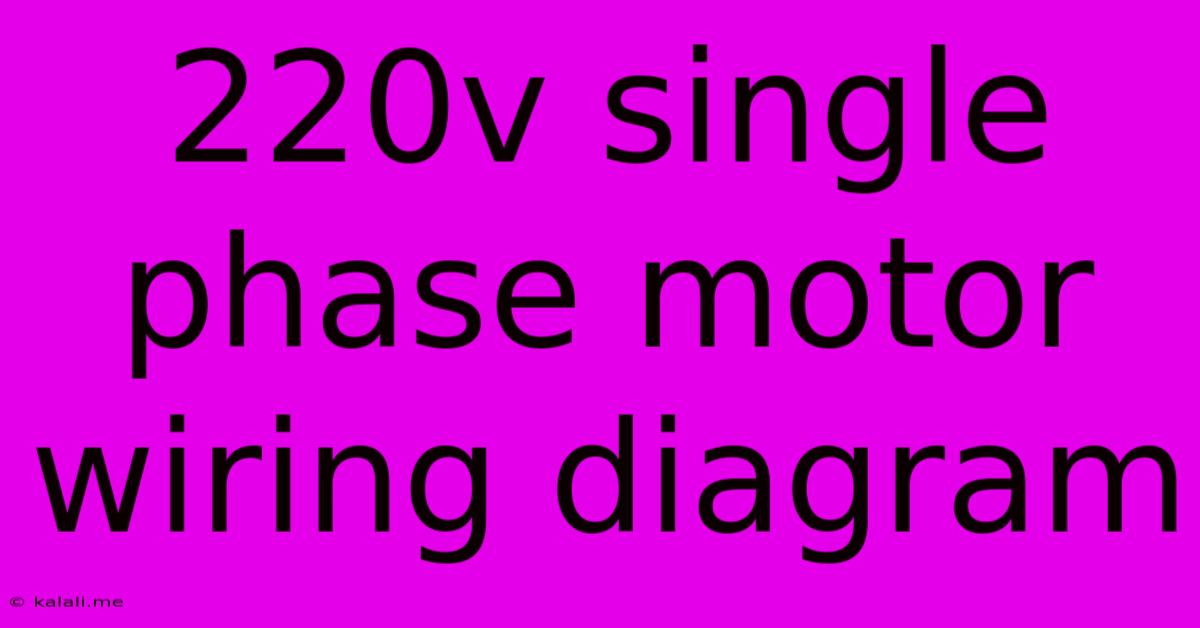220v Single Phase Motor Wiring Diagram
Kalali
Jun 07, 2025 · 3 min read

Table of Contents
220V Single Phase Motor Wiring Diagrams: A Comprehensive Guide
Connecting a 220V single-phase motor correctly is crucial for its safe and efficient operation. This article will provide you with a comprehensive guide to understanding different 220V single-phase motor wiring diagrams, focusing on capacitor-start and capacitor-run motors, the most common types found in household and small industrial applications. Understanding these diagrams will help you troubleshoot problems and ensure your motor runs smoothly.
Understanding Single-Phase Motor Types
Before diving into the wiring diagrams, it's essential to understand the different types of single-phase motors. While several exist, capacitor-start and capacitor-run motors are prevalent.
-
Capacitor-Start Motors: These motors use a capacitor only during the starting phase to help the motor overcome its inertia and begin rotating. Once the motor reaches a certain speed, the capacitor disconnects from the circuit. They are generally less expensive and suitable for applications with infrequent starts.
-
Capacitor-Run Motors: These motors utilize a capacitor continuously during operation, providing a higher starting torque and smoother running compared to capacitor-start motors. They are ideal for applications demanding consistent torque and frequent starts.
-
Permanent Split Capacitor (PSC) Motors: These motors have a capacitor permanently connected in series with the auxiliary winding. They are simple, but offer lower starting torque than capacitor-start or capacitor-run motors.
Common 220V Single-Phase Motor Wiring Diagrams
Wiring diagrams will vary slightly depending on the manufacturer and motor specifications. However, the general principles remain consistent. Always refer to the motor's nameplate for precise wiring instructions.
Important Note: Always disconnect power before working with any electrical equipment.
Capacitor-Start Motor Wiring Diagram
This diagram typically shows two windings: the main winding and the auxiliary winding. The capacitor is connected in series with the auxiliary winding, only engaged during the starting phase via a centrifugal switch.
- Main Winding: Connected directly to the 220V power supply.
- Auxiliary Winding: Connected to the 220V supply through the capacitor and centrifugal switch.
- Centrifugal Switch: This switch disconnects the auxiliary winding and capacitor once the motor reaches a certain speed.
The diagram will illustrate these components and their connections clearly, usually using a simplified schematic representation.
Capacitor-Run Motor Wiring Diagram
The capacitor-run motor wiring diagram is simpler than the capacitor-start diagram because the capacitor remains connected during the entire operation.
- Main Winding: Connected directly to the 220V power supply.
- Auxiliary Winding: Connected to the 220V supply through the capacitor. This capacitor is usually a higher-capacity unit compared to those used in capacitor-start motors.
The diagram will show a permanent connection between the capacitor and the auxiliary winding.
Identifying Motor Components
Before attempting any wiring, it's crucial to identify the motor's components correctly. Look for labels on the motor terminals, usually labeled 'L1', 'L2', 'C' (capacitor), and possibly others depending on the motor's construction.
Troubleshooting Common Issues
If your motor isn't running correctly, several issues might be the cause:
- Incorrect Wiring: Double-check the wiring against the motor's nameplate diagram.
- Faulty Capacitor: A bad capacitor can prevent the motor from starting or cause it to run inefficiently.
- Open or Shorted Windings: These issues require professional repair.
- Overloaded Motor: The motor may be too small for the load it's trying to handle.
Safety Precautions
Working with 220V electricity can be dangerous. Always prioritize safety:
- Turn off the power: Before working on the motor, ensure the power is completely disconnected.
- Use appropriate tools: Employ insulated tools to avoid electrical shock.
- Seek professional help: If unsure about any aspect of the wiring, seek assistance from a qualified electrician.
This guide offers a general overview of 220V single-phase motor wiring diagrams. Always consult the specific wiring diagram provided by the motor manufacturer for precise instructions and safety guidelines. Remember, safety is paramount when working with electricity.
Latest Posts
Latest Posts
-
Small Signal High Frequency Rf Transistord
Jun 07, 2025
-
How To Get Pick Block In Minecraft Java
Jun 07, 2025
-
How To Close Tabs On Android Phone
Jun 07, 2025
-
I Didnt Approve Overtime But An Employye Worke
Jun 07, 2025
-
In The Harry Potter Universe Do Potions Work On Muggles
Jun 07, 2025
Related Post
Thank you for visiting our website which covers about 220v Single Phase Motor Wiring Diagram . We hope the information provided has been useful to you. Feel free to contact us if you have any questions or need further assistance. See you next time and don't miss to bookmark.